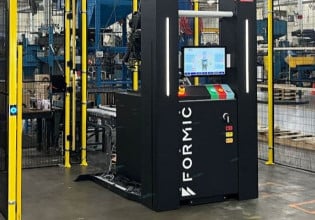Memory: A Challenge on the Road to Industry 4.0
Memory for data is among the most pressing challenges to Industry 4.0. Given the evolving nature of Industry 4.0 and associated memory solutions, however, some memory-based trends are becoming apparent.
The integration of modern digital technology into industrial facilities is rapidly growing across the world—but it is not without its challenges. One of the main problems related to Industry 4.0 lies in the ability to process the data at a significantly higher magnitude and throughput in a reliable, error-free manner.

Figure 1. Combining massive amounts of data, extensive process automation, powerful artificial intelligence, and changing where the data analysis takes place, Industry 4.0 is changing how many industries worldwide are doing business.
Industry 4.0
Industry 4.0 is the generally adopted label for the fourth industrial revolution, including several hallmarks such as the development and widespread adoption of process automation, extensive data collection, machine-to-machine communication, and enhanced data analysis. Also included is localized (machine-level) artificial intelligence and decision-making at the edge rather than at a centralized location.
Memory: A Roadblock on the Road to Industry 4.0
Data is the most critical aspect of Industry 4.0 because the retrieval, processing, communication, storage, and availability of data are crucial to what makes Industry 4.0 possible. For example, consider how sensors generate massive amounts of data to be logged and processed in real time. Sensor data passes through modern industrial controllers and field devices, interacting with three kinds of memories in the system: flash, expansion RAM, and data-logging RAM. Memory is among the most pressing challenges to be overcome on the road to Industry 4.0.
Real-World Application Memory Needs
Many industrial systems use various external memories to fulfill different functions. Embedded systems that are commonplace on a factory floor include programmable logic controllers (PLCs), servo motor drives, CNC machines, and industrial robots. These systems usually include the following building blocks (see Figure 2), which include an application processor, several I/O peripherals, wired and wireless connectivity, sensors and transducers, and three different types of memories.

Figure 2. Block diagram of an industrial system.
Industrial systems like PLCs use an external flash memory device, typically having sizes upwards of 256-Mbits for storing the boot code. These memories need to support very fast read performance and features like eXecute-in-Place (XiP), so the system can execute the code directly from the NOR flash memory without the overhead of copying it into the RAM.
Data-logging RAM supports the ability to write real-time I/O and sensor data at extremely fast speeds while still being able to capture mission-critical data instantly on power loss. Most industrial systems must continuously and accurately log data over a 15-year lifespan while operating in harsh environments. Industry 4.0 relies on continuous data to prevent failures before they occur and minimize system downtime—a process called predictive maintenance. The RAM solutions for this type of memory need to execute millions of read/write operations throughout the product’s lifespan reliably and accurately. Also, keep in mind that aggressive environments will include temperature extremes, which often prove challenging for certain types of memory.
The internal processors, such as a microcontroller or an FPGA, may not have sufficient internal SRAM for executing complex algorithms and storing system run-time data temporarily. Modern industrial systems use an expansion RAM to augment the limited internal RAM, as a high-speed scratchpad memory to run the user applications seamlessly. An industrial robot or a machine vision system includes a display and uses the expansion RAM to buffer image frames for the graphical display. They also require an optimized external memory interface IP and a low pin-count solution to reduce design complexity and optimize system power.
Flash Memory Challenges
NOR Flash technology is responsible for storing boot code and data. It must be highly reliable, provide excellent safety and security, and meet strict industry requirements when used as part of Industry 4.0 technology. Another challenge for NOR flash memory involves the ability to remain functional in the extreme temperature environments that are common to many industrial systems.
Expansion RAM Challenges
Embedded designs performing RAM-intensive applications require large amounts of temporary storage for data buffering and typically depend on DRAMs as expansion memories. While DRAMs offer scalability and high performance, they also involve higher power consumption, added design complexity, and occupy a larger PCB footprint.
Data-Logging RAM Challenges
Figure 3 shows massive amounts of data from numerous sensors, equipment, and processes generated every second in a smart manufacturing environment. Therefore, an essential aspect of data-logging memory involves instantly capturing and maintaining data backup during power disruption. The most prevalent solution for data-logging in legacy industrial automation systems is battery-backed SRAMs (BBSRAMs) where a conventional low-power SRAM is bundled with a battery and additional power supervisory circuitry to create a non-volatile memory.

Figure 3. The massive amount of data generated by machine and system sensors must be stored and processed. Image used courtesy of Infineon
However, there are potential issues with battery maintenance and replacement, bit errors induced by electromagnetic devices or cosmic radiation, and design complexity from the added supervisory circuitry. Using batteries in the design leads to reliability concerns; consequently, engineers seek to eliminate battery disposal, enhance RoHS compliance, and reduce battery maintenance.
Future Memory Trends
Given the evolving nature of Industry 4.0 and associated memory solutions, some memory-based trends are becoming apparent.
Bias Toward Higher Performance
Modern industrial systems will require higher-performance random-access memories that cause no latency. As the quantity of incoming data increases, higher random accesses are necessary for better performance. Further, these accesses must be instantaneous (at bus speeds) and must be achieved without the overhead of page accesses and limited endurance.
Bias Towards Higher Densities
As more sensors are integrated into industrial systems, and more remote I/Os must interface with central controllers, there will be a massive increase in the data generated. This data must be stored locally for processing and predictive maintenance to minimize system downtime. As the magnitude of sensor data generated at the edge increases, higher-density non-volatile memories will be required to log this data in real time. Similarly, more complex industrial systems demand higher-density NOR Flash memories for code and system data storage.
Infineon currently offers up to 16 Mbits of non-volatile RAM storage with the F-RAMs and nvSRAMs, while ULP SRAMs go up to 64 Mb. Infineon’s exclusive MIRRORBIT technology doubles the number of bits per cell for high-density NOR Flash memories.
Bias Toward Greater Reliability
Industry 4.0 requires robust operation in extremely challenging environmental conditions. Reliable data logging is required to ensure seamless recovery of a power failure and limit the downtime of industrial systems. Additionally, electromagnetic interference (EMI) resulting from motors operating on the factory floor may impact the contents of memories used in industrial systems. Infineon’s F-RAM and nvSRAM memories are immune to the effects of magnetic field interference and are amongst the industry’s most reliable data-logging memories.
With the integration of security features in next-generation systems, manufacturers demand hardware security elements in the code storage memory to protect against cyber threats and prevent tampering. Infineon’s latest generation of SEMPER Secure NOR Flash memories provides an immutable root-of-trust for secured boot and key management to enable remote firmware updates—secured from cloud to memory.






